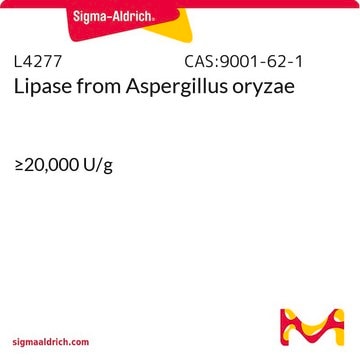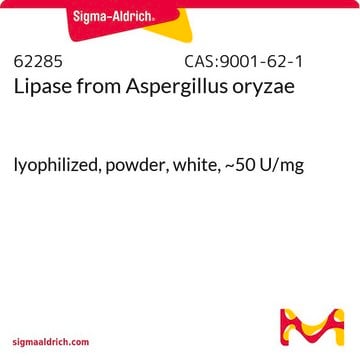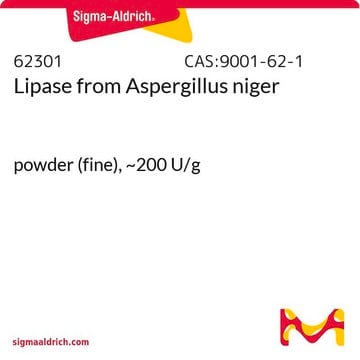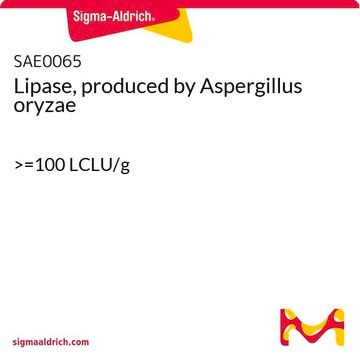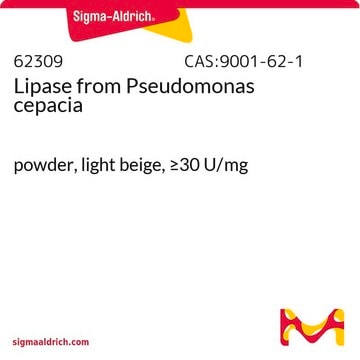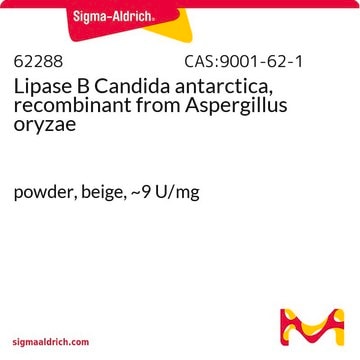L0777
Lipase from Aspergillus oryzae
solution, ≥100,000 U/g, white, beige
Sinonimo/i:
AOL, Lipolase 100L
About This Item
Prodotti consigliati
Origine biologica
Aspergillus sp. (Aspergillus oryzae)
Forma fisica
solution
Attività specifica
≥100,000 U/g
Condizioni di stoccaggio
(Tightly closed. Dry)
tecniche
cell based assay: suitable
Colore
beige
white
Temperatura di conservazione
2-8°C
InChI
1S/C11H9N3O2.Na/c15-8-4-5-9(10(16)7-8)13-14-11-3-1-2-6-12-11;/h1-7,16H,(H,12,14);/q;+1/b13-9-;
QWZUIMCIEOCSJF-CHHCPSLASA-N
Cerchi prodotti simili? Visita Guida al confronto tra prodotti
Descrizione generale
Lipase is derived from Aspergillus oryzae by ammonium sulfate precipitation and chromatography.Lipases or triacylglycerol acyl hydrolases are a group of hydrolase enzymes that are usually found in humans and animals with monogastric stomachs. Lipase enzymes are generally formed in the pancreas and stomach where they aid in fat and lipids digestion.(2)
Applicazioni
- as a control enzyme in activity assays
- as a component in lipolase stock solution for the hydrolysis experiments
- to incubate scaffolds for lipase-accelerated degradation experiments
- as the lipolytic enzyme standard to detect lipolytic enzymatic activity via chromogenic agar plates and zymography
Azioni biochim/fisiol
Nota sulla preparazione
Note legali
Anticorpo
Enzima
Prodotti correlati
Substrato
Avvertenze
Danger
Indicazioni di pericolo
Consigli di prudenza
Classi di pericolo
Resp. Sens. 1
Codice della classe di stoccaggio
11 - Combustible Solids
Classe di pericolosità dell'acqua (WGK)
WGK 1
Punto d’infiammabilità (°F)
Not applicable
Punto d’infiammabilità (°C)
Not applicable
Dispositivi di protezione individuale
Eyeshields, Gloves, type N95 (US)
Certificati d'analisi (COA)
Cerca il Certificati d'analisi (COA) digitando il numero di lotto/batch corrispondente. I numeri di lotto o di batch sono stampati sull'etichetta dei prodotti dopo la parola ‘Lotto’ o ‘Batch’.
Possiedi già questo prodotto?
I documenti relativi ai prodotti acquistati recentemente sono disponibili nell’Archivio dei documenti.
I clienti hanno visto anche
Il team dei nostri ricercatori vanta grande esperienza in tutte le aree della ricerca quali Life Science, scienza dei materiali, sintesi chimica, cromatografia, discipline analitiche, ecc..
Contatta l'Assistenza Tecnica.